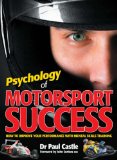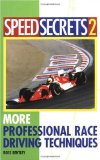Mentally, you need to get yourself ready to win. Close your eyes, relax, and take a few deep breaths. Picture yourself at the end of the race crossing the finish line. No really – stop looking at this screen for a moment and try it.
What place did you finish in? You need to be able to visualize yourself crossing the finish line and winning. If you don’t believe you have the possibility of winning races, you most likely won’t win. Taking it a bit further, if you see yourself as a slow driver, you will manifest these traits in races. On the other hand, if you learn to see yourself as a winner and a competent driver, this too will manifest itself in performance. Don’t worry if you did not picture yourself winning; I personally found this to be a difficult task at first. It may take some work to get to that point.
You may think this sounds a bit crazy, but begin your visualization process by getting into your racecar with your helmet and driver’s gloves on. Let go of worries about looking or feeling stupid. (Although if you have a garage, that would be the ideal place to do this.) While getting into the racecar will enhance this exercise, you can also use mental imagery just about anywhere. It is helpful to find a quiet place though. Now close your eyes and take four deep breaths, inhaling and exhaling slowly. If you are not physically in the racecar, envision yourself in the car. Visualize your surroundings on the grid. Feel the weather, hear the sounds, inhale the smells – imagine everything as if you are there. Picture the workers while you drive the track. Since this is the qualifying session, don’t focus much on the other cars on the track. Instead, spend time visualizing turning perfect laps in your head. Drive each lap with the perfect line and the least amount of braking needed. Feel the racecar and how it reacts to bumps on the track, when you brake and go around turns. Envision everything just the way it should be done. If you make a mistake while visualizing, go back, rewind, slow down the image in your mind, and do that part of the track over again. While doing this exercise, control your breathing. The qualifying session is now completed, and you drive back to your paddock spot. You are now ready for the race. Take a minute, open your eyes and relax.
Close your eyes again and take a few more deep breaths. Picture yourself on the grid again. And yes, you qualified first. As you did before, visualize all of your surroundings. The corner worker signals for you to enter the track and begin the warm-up lap. Picture the corner workers waving to you as you warm your tires and brakes. As you begin to approach the starting line, focus even harder, as you would in a race. Feel the anticipation as you watch for the green flag to be waived. Visualize a perfect race. Focus on hitting every apex and carrying the perfect amount of speed in every corner…Before you know it, this will transition over to when you drive on the track.
Mental imagery has no monetary cost – use it!
Having Self-confidence Matters!
You will find that some drivers try to “psych-out” other competitors with their false self-confidence. During one of my races, a driver who qualified two cars behind approached me. The driver was someone I had heard about, and whom I had recognized as being pretty quick out on the track. He said that I had better watch out or I may end up adding another dent to his car. I looked over, and his car surely had many dings on it. As you might imagine, I was a bit annoyed with him. During the first lap he was successful in getting by me and a few other people. How does the old saying go? What comes around goes around. During the fourth lap I saw him and his car off in the grass. I later learned that his car had a mechanical issue, causing the car to cease running. I can’t say I felt too bad for the guy. I had a pretty good laugh at his expense!
Instead of using this tactic, work at developing real inner confidence. It’s a more sure-fire and stable option. The only thing you really have control over is yourself. Don’t invest too much effort in trying to control the actions or reactions of other drivers. After you have truly developed self-confidence, you will be less likely to be affected by the actions of other drivers, and you will be better able to react to and adjust to unusual situations or track conditions.
Goal setting is a very effective way to build self-confidence. Develop short-term, realistic and attainable goals. Throughout your club racing career, you should be establishing goals and revisiting them. Setting measurable goals, achieving them, and establishing new goals, while recognizing your achievements, will prove to be beneficial.
Nothing builds confidence like success. Depending upon the clubs in your area, it might be worthwhile (and fun!) to race with a club where the competition is not as strong. This is not saying that the drivers are not talented, but often the racecars may not be built to their maximum potential. By doing well and running in the front of the pack with them, you will build your confidence.
In Sacred Hoops: Spiritual Lessons of a Hardwood Warrior (1995), former NBA coach of the Chicago Bulls and Los Angles Lakers Phil Jackson wrote:
“In basketball – as in life – true joy comes from being fully present in each and every moment, not just when things are going your way. Of course, it’s no accident that things are more likely to go your way when you stop worrying about whether you’re going to win or lose and focus your full attention on what’s happening right at this moment.”
Relax and have fun! The results will take care of themselves.
Physical Aspects
Many racers in the club level underestimate the importance of physical conditioning. Auto racing demands the highest level of performance from you, the driver. Small errors causing only tenths-of-a-second setbacks can make the difference between winning and losing. Being in good physical shape does impact your driving abilities. Especially as you get further into the race itself, having worked on your cardiovascular endurance will pay off. There are reasons why professional racers have personal fitness trainers and place an emphasis on physical conditioning. You also need to make sure that you get plenty of sleep and drink plenty of water before the event.
What Are Other Things You Can Do?
- Obtain additional seat time. Prior to attending practice days, establish goals for yourself and identify areas that you want to focus on. Maybe you are having a difficult time with a particular turn? Obtain suggestions from other drivers, and test these new techniques.
- Seek additional coaching. It is not necessary to go to an expensive racing school to accomplish this. Talk with other drivers, and possibly post a discussion on your favorite racing thread to determine who might be able to assist you. Approach another seasoned racer who is well-respected in racing to see if he would be willing to provide you some paid coaching at an open track day. Do remember that, just because someone is an excellent driver, it does not mean they will be an excellent coach. The person you seek should typically be someone who drives a racecar in a different class. Maybe even someone who drives in a different series. (No one wants to give away all of their secrets to a fellow competitor.)
- Continue to study your in-car video. Pay attention to your driving techniques and to those of other people.
Reading Recommendations
 Psychology of Motorsport Success: How to improve your performance with mental skills training by Dr. Paul Castle
Psychology of Motorsport Success: How to improve your performance with mental skills training by Dr. Paul Castle
Most of us spend plenty of time on making our cars faster and continue to seek ways to develop them. We recognize that learning racing techniques is another component to becoming a successful racer and many have started to realize the benefits of physical fitness. There still remains one area that many racers overlook which is a key to obtaining an edge over competitors – the human mind. Few racers are schooled in the use of psychology to develop the mental strength required to be the best of the best. In racing, confidence and the ability to approach the sport with the right mental outlook is vital to your success. This book is written in down-to-earth language and will provide you the ‘psychological skills training’ package that with practice will improve your approach to racing.
 Inner Speed Secrets: Mental Strategies to Maximize Your Racing Performance by Ross Bentley
Inner Speed Secrets: Mental Strategies to Maximize Your Racing Performance by Ross Bentley
Maximize your driving ability with tips from the experts! Based on performance seminars conducted by the authors for race car drivers, this informative guide helps you consistently perform at your highest level. Chapters discuss: The Driver – The Ultimate Management System; Inner Race Driving; Skills and Techniques; and Strategies. This is another well written book in the Speed Secrets series.
 The Mental Athlete by Kay Porter
The Mental Athlete by Kay Porter
The Mental Athlete teaches you how to visualize, do relaxation exercises, and develop mental training programs. While it’s not written specifically for motorsports, the basis can be applied to all sports. It contains exercises, tests, and worksheets that will guide you through the steps of mental achievement for improved performance. This conditioning manual for the mind helps you -enhance mental strengths and address weaknesses through self-assessments, increases confidence in personal abilities and overcome the fear of failure, heighten awareness of inner-thought processes and teaches ways to improve them. Maximize your physical skills by fully developing your mental skills using this book.
